Features
Hardware compression, decompression
of PAL, NTSC into MPEG2 or MPEG1
30 fps on 704 x 480 size interlaced images
Programmable bit rates
Two RS-232 ports for controlling pan-zoom-tilt cameras
Display & Control software
DVR with optional storage
Internal web server and dynamic web pages
Several wireless options
Additional video channels with 512 adapters
Optional enclosures

Embedded Linux
Description
Model 2412 is a complete
video server streaming solution. It converts analog video into
digital data, compresses it into MPEG formats and then transmits it
over an Ethernet using the UDP or RTP protocol. It is made
from Sensorayís 512 MPEG-2 codec, 301-6
CPU and 207
power supply. The 2412 has options to record video clips that may be
played back locally on the 2412 or sent over the Ethernet for remote
viewing. More sophisticated versions can process four video streams
simultaneously and transmit them over a wireless Ethernet.
Since the 2412 is bi-directional, it can accept an Ethernet stream
from another 2412 and convert the encoded digital video into
composite video outputs.
Hardware
Decoding
Although it is possible to use 2412 hardware to
decode MPEG data, this process does not have low latency compared to
Sensorayís Display & Control software. 2412 hardware latency is
5 seconds, while our software playerís latency is less than one
second.
Software Decoding
If the 2412 is
programmed to stream data using the RTP protocol then Apple
Computer's QuickTime stream player may be used.
Sensoray
sells Display
& Control software for the 2412 that allows viewing
multiple image streams in near real time on Windows systems. It has
less than one second of latency, which allows accurate camera
adjustments.
Two versions of the stream player are for sale.
One is a stand-alone Windows program and the other is a DLL for
embedded systems. The viewer allows stopping the display on a single
frame for viewing or printing. The image stream may also be sent to
a disk file.
Software and Manuals
2412 Instruction
Manual >> Released 11/7/02
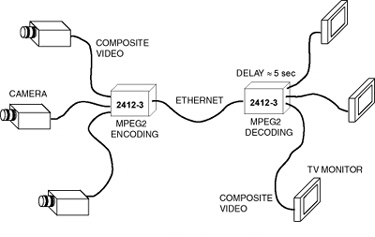
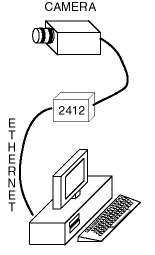
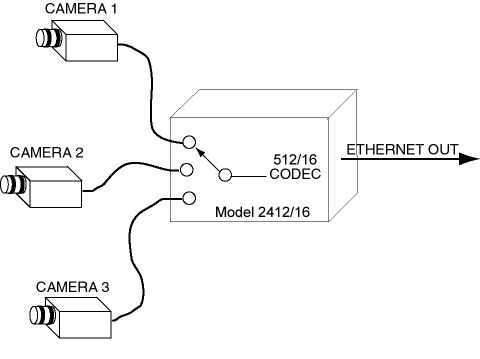
Ethernet
Protocols
The UDP format (user datagram protocol) offers the
fastest data rates and minimum CPU usage at the expense of minimal
error checking. The 2412-4 can uni-cast four MPEG2 data streams at
full frame rates when using this protocol.
A disadvantage of the UDP format is that it cannot
be played using popular stream players such as QuickTime. However,
the latency i.e., the time delay between recording and displaying,
while using these players, can be several seconds.
Multicasting
Video streams from 2412ís may be
viewed simultaneously by several clients on the same network by
using multicasting. The 24xx automatically stops multicast
streaming to RTP clients once they close their RTP player.
Multicasting may be replaced with uni-casting by sending a command
to the 24xxís command processor.
The RTP format (real time
protocol) trades off CPU and memory usage for error correction and
compatibility with QuickTime and Real Player. Sensoray sells a
multi-stream, low-latency software RTP player for Windows 2000 and
XP. The latency of Sensoray's software player can be as low as one
half second when processed on a 2 GHz, Pentium-4 system. A
disadvantage of RTP is that it uses twenty-five percent of the
2412ís CPU time, while UDP uses less than five percent. Hence,
the 2412 can only support two RTP streams.
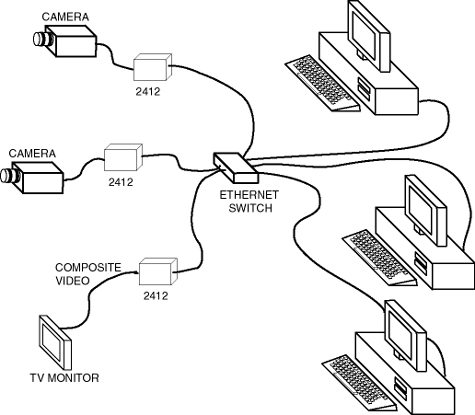
Wireless Options
Adding a 340-11b/1
option board to the PC/104 stack adds 802.11b wireless Ethernet to
the 2412. The 30 mW output from this board may be connected to
our 2400-OMNI antenna and used for line-of-sight ranges of up to 500
feet. The 340-11b/1 board is supplied with the 2412C3 cable
that has a type-N bulkhead connector. The operating range can
be extended by using our 2400P patch
antenna or 2400G reflector
grid antenna. The 340-11b option adds about one watt to the
2412ís power dissipation.
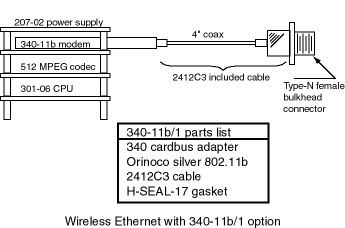
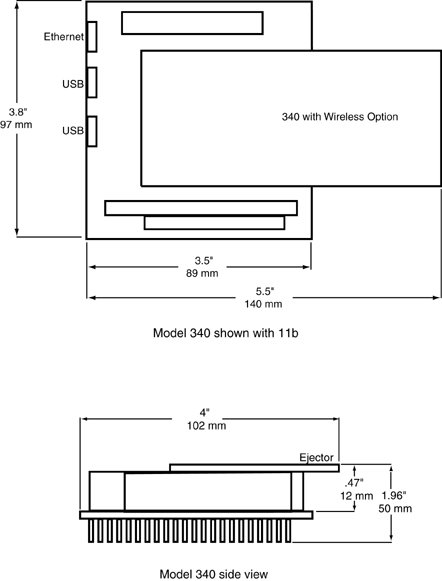
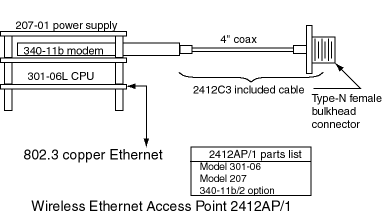
Long-range
Wireless
The wireless range can be extended to beyond one
mile by using the 340-11b/2 option in place of the un-amplified
340-11b/1. The 340-11b/2 option adds a 500 mW linear
amplifier. This option adds approximately five watts to the
2412ís total power dissipation. Model 340-11b/3 is available
with 1000 mW linear amplifier (2400-1000RF). Adding this option
increases the 2412ís power dissipation by an additional 10 watts.
Using these power amplifiers in the U.S. may violate FCC
regulations. Sensoray requires a special statement-of-use
form before sending these amplifiers to U.S.
destinations.
The wireless Ethernet is bi-directional; hence,
the other end of the data link must have an equivalent amplifier and
directional antenna. Sensoray recommends using the 2400G, a
reflector grid antenna, at both ends to minimize interference and
maximize the range.
Antennaís
offered by Sensoray
Wireless Access Points 2412AP/1 and
/2
The 2412 includes Ethernet router software that can route
802.11b wireless data to one of its 802.3 wired Ethernet ports. This
allows the 2412 to operate as a wireless access point. When the 2412
is configured as a 30 mW access point it becomes a 2412AP/1.
When it is configured as a 500 mW access point its part
number is 2412AP/2. The Sensoray access point products do not
include an MPEG codec because they process just Ethernet
data.
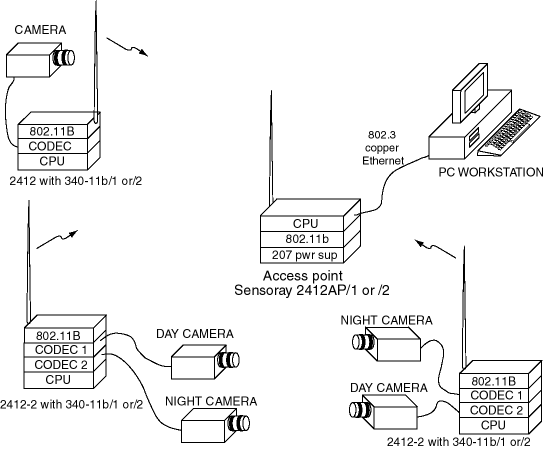
Sensoray's 2412AP/2 access point has the advantage of higher RF output power and higher input amplifier gain. Other brands of 802.11b access points hardware may be used with remote 2412's. These include Lucent's RG-1100 and Cisco Systems 350 series.
Display and
Control Software
Sensoray's real-time Display and Control
Software decodes and displays up to fifteen MPEG1 and/or MPEG2
streams with a low latency of 1/2 to one second. Thumbnail images
from remote video servers may be positioned over a background such
as a map or building plan. Multiple server images may be selected
for expansion to full size and full frame rate.
Digital
Video Recorder
Video clips may be stored on 2412 servers that
have internal storage media as described in this section. The movies
may be replayed from local or from remote 2412ís or they may be
rapidly downloaded to remote clients. For example, the daily movies
accumulated in a vehicleís DVR may be rapidly transferred over an
802.3 wired Ethernet.
Movies can be stored on a
removable compact flash card. In the local record mode, MPEG
data from the codecs is recorded to storage media. Proper care is
taken to prevent significant data loss in the event of a power
loss. While data is being recorded it is also available as
composite video from the codecs.

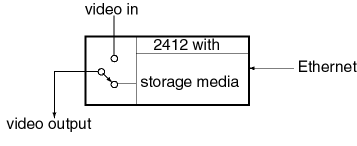
Once MPEG video data is stored on the 2412 it may be decoded and
viewed by using the 2412ís hardware decoding and composite video
output channel.
Recorded movies can also be sent over the
Ethernet for remote viewing with QuickTime or Real Player. In this
case, the 2412 sends MPEG data which the software player must
decode.
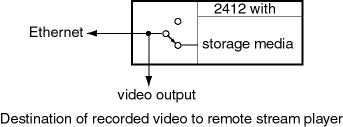
Video Storage
There are three storage
options. Video clips may be stored on a 2.5 inch IDE hard drive by
adding the 300TA interface board and IDE cable. IDE mechanical hard
drives have limited temperature and vibration specifications, hence,
they are not recommended for use in vehicles or outdoors
environments. Some 2.5-inch hard drives may draw too much
power from the 2412's power supply and must be powered by an
auxiliary power source. Mechanical IDE hard drives have the
advantage of low cost and high density.
Web
Server
The 24xx is an Ethernet appliance that executes
commands from a Telnet command line, Sensoray's Display & Conrol
software or from its internal Apache web server. Most browsers can
control and display information from the 24xx. Each 24xx supports
four video channels that are assigned to separate ports.
Micro Drives, a miniature hard drive mounted on a cardbus
board, may be used with model 340 adapter board. They are more
rugged than conventional IDE hard drives and do not require any
cables. They are three to five times more expensive than IDE drives
and limited to about one gigabytes of storage.
The dynamic
web pages will only display data and selection boxes that are
relevant to previously made selections. For example, DVR selection
boxes are not displayed if the DVR function has not been previously
selected. One of the web pages is shown below.
Compact flash
modules may be used with the 340 option board. They are rugged solid
state storage media with capacities up to one gigabyte. They appear
as a mountable disk drive to the Linux OS. These modules are limited
to 300,000 memory write cycles, hence, they do not have the
versatility of mechanical hard drives. We have developed drivers for
Luxor ATA and Sandisk modules.
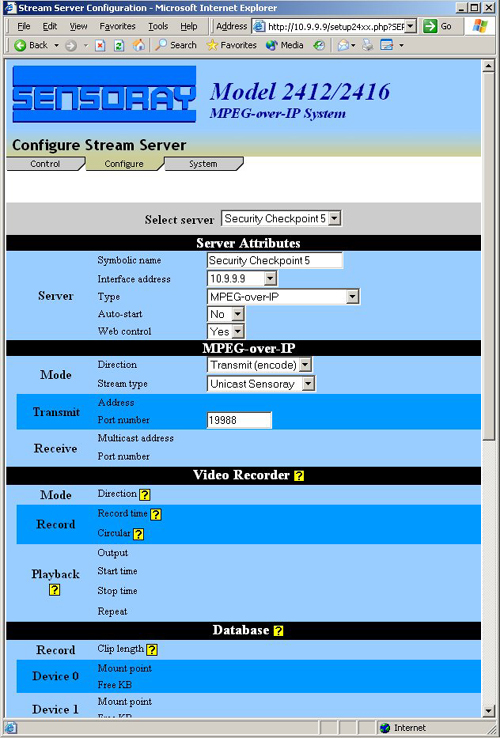
Camera Control
The
2416's CPU sends pan, tilt and zoom command from the Ethernet to one
of the RS-232 ports. Many cameras use serial ports for position
control. PZT software is included for popular camera assemblies such
as Sony (Visca), Pelco (D protocol) and Cohu (iDome).
To
facilitate camera adjustment the digitized video can be looped back
to the composite video output for viewing on a TV monitor. This is
the default mode for the video output.
Bit Rates and
Bandwidth
The data rates discussed below refer to the bit
rate from the MPEG codec used by the 2412. The rates do not refer to
Ethernet bit rates, which are fixed at 10 Mbits/sec or 100
Mbits/sec. The 2412's programmable bit rate allows trading image
quality for bandwidth.
Higher bit rates from our MPEG codec
give better quality images than lower rates. Full-size
interlaced images of 30 frames/sec will start to show distortions
below 1 Mbits/sec, however, image quality improves only slightly
above this rate.
When low bit rates are selected e.g., 100
kbits/sec, the amount of distortion depends on the amount of motion
in the scene. A chess game will have less distortion than a soccer
game.
A variable bit rate may also be selected. This
mode tries to maintain good image quality by varying the codec bit
rate according to the amount of motion in the scene.
It is
also possible to decrease the bandwidth by decreasing the image
size. Selecting CIF size images of 320 x 240 pixels will
reduce the required bit rate by four compared to 640 x 480 pixel
images that occur at the same frame rate.
If there is not much motion in a scene, a lower
frame rate may be selected to reduce the codec's bit rate. Lower
frame rates will show motion artifacts from fast-moving objects.
Even though such as stream can be recorded at a lower frame rate,
most MPEG viewing programs will play the stream at 30 frames/sec for
NTSC and 25 frames/sec for PAL. The stream will be playing in a
fast-forward mode. For example, a 15-frame/sec recording will be
displayed at twice the normal frame rate.
Programmable
bit rates
A frame rate of less than 30 fps may be selected by
programming a frame divider greater than 1. For example, a
frame divider of 3 will program the codec to process 10 fps.
The effective bit rate may be throttled down to
below 50 kbits/s by programming the frame divider and codec bit rate
to high values. For example, specifying a codec bit rate of 1.5
Mbits/s and a frame divider of 15 will result in an effective bit
rate of 100 kbits/s.
Embedded Linux
The board set
is supplied with specially configured Linux for high reliability and
fast response. After power is applied, the software is automatically
loaded to RAM from flash memory. The 2412 will then stream MPEG data
to the Ethernet port.
Sensoray has optimized Linux
installation for the 301-6 CPU. Although it is possible to recompile
the Linux kernel, Sensoray does not offer technical support for this
operation.
Breakout board 2400TA
This termination
board offers a convenient means of connecting signals to the
circular connectors on a 2412SYS. It provides DB-9 connectors for
the serial ports, an RJ-45 connector for the Ethernet port and coax
connectors for the video. A line-operated 24VDC power supply, model
208 and two interconnecting cables are supplied. These connect the
2400TA to one of three types of 2412's: model 2412SYS, 2412 card
stack and 2412SYS-Mini.
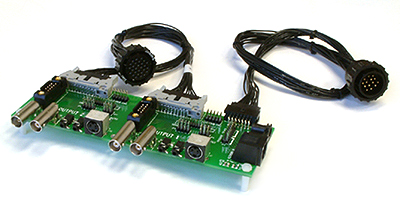
Enclosures
The 2412 is still available
as an unpackaged stack of PC/104 boards. It is also available in one
of three sealed enclosures. Models 2412SYS & 2412SYS-2 have
space for four PC/104 boards and a small hard drive. A larger
enclosure is also available that has space for 6 PC/104
boards. A typical 2412SYS or 2412SYS-2 configuration is shown
below. Optional storage media must be added for DVR operation.
2412 Stack
2412SYS-11b
Typical 2412SYS & 2412SYS-2
configuration
CPU
>> 301-6L with Linux, web server
Codec >> Up to two
512ís
Wireless option
>> 340-11b/1 board, 2400P antenna, 2400PM pole mount
kit
PC/104
boards >> Four maximum
Figure 11. 2412SYS and 2412SYS-2
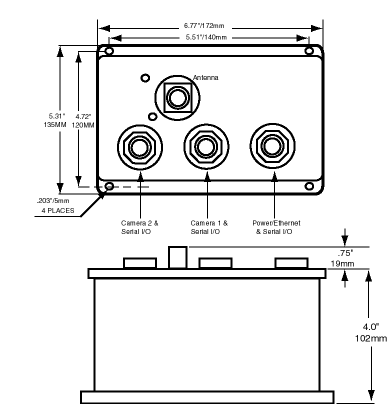
Model
2412SYS-3 & 2412SYS-4 has increased expansion
compared to model 2412SYS. This larger size enclosure is designed
for four MPEG channels and one 340-11b/1 wireless option. It has
special thermal features that allow using an internal 20-watt power
supply and 500 mW RF amplifier. Optional storage media must be added
for DVR operation.
Typical 2412SYS-3 & 2412SYS-4
configuration
CPU
>> 301-6L with Linux, web server
Codec >> Up to four
512ís
Wireless option
>> 340-11b/1 board, 2400P antenna, 2400PM pole mount
kit
PC/104 boards
>> Six maximum
Model 2412SYS-MINI is a single channel system designed for use in limited space. It uses our 301-6L Linux CPU, model 206 power supply and one 512 codec.
Typical 2412SYS-MINI configuration
CPU >> 301-6L with
Linux, web server
Codec >> One
512
Power supply
>> 206
PC/104
boards >> Two maximum
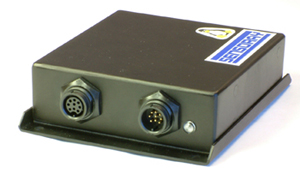
Figure 12. 2412SYS-MINI
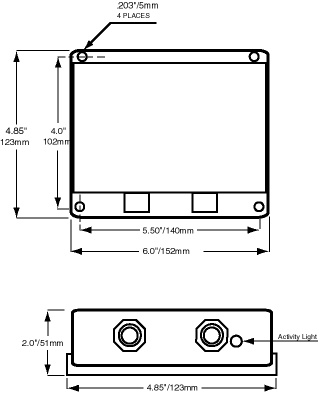
Our standard product, model 2412, uses our 301-6L Linux CPU. Variations of this product are shown below. Although our 24xx software may run on other CPU's only Sensoray supplied CPU's are supported. Sensoray will not assist anyone installing our software on other computers.
|
Model 2412 |
Model 2413 |
Model 2416 |
|
Codec 512 without audio |
512 without audio |
516 with audio |
|
Power supply 207 |
202 |
207 |
|
CPU 301-6L |
302L |
301-6L |
|
133 MHz Elan |
300 MHz Geode |
133 MHz Elan |
|
16 MB flash |
32 MB compact flash |
16 MB flash |
|
32 MB RAM |
128 MB RAM |
32 MB RAM |
|
2 serial ports |
2 serial ports |
2 serial ports |
|
No VGA, IDE, printer port, USB |
VGA, IDE, printer port, USB |
No VGA, IDE, printer port, USB |
|
One 10/100 base-T |
Two 10/100 base-T |
One 10/100 base-T |
|
Power dissipation 7 watts |
Power dissipation 15 watts |
Power dissipation 8 watts |
|
2412 General Specifications |
|
|
Software supplied |
Linux 2.4.10 kernel |
|
|
Linux driver for 512 codec |
|
|
Linux network API |
|
Video input |
725 x 500 PAL |
|
|
640 x 480 NTSC |
|
MPEG type |
30 f/s MPEG1,2 elementary stream |
|
Ethernet |
10/100 base-T |
|
Protocols |
Ethernet UDP, RTP |
|
Serial ports |
Two RS-232 |
|
Watchdog timer |
1.6s time-out, open collector |
|
Memory |
16 MB flash, 16 MB SDRAM |
|
CPU |
Sensoray Model 301-6 |
|
Power supply |
Sensoray Model 207-01, Model 207-02 with 340-11b/2 |
|
PC I/O board |
Model 300TA - Optional PC I/O board for IDE drives |
|
Input power |
4.5 watts, 12 to 35 VDC without
wireless |
|
Ordering Informations |
|
|
Model 2412 |
Incorporates 1 model 512 frame grabber, |
|
Model 2412-2 |
Incorporates 2 model 512 frame grabbers, |
|
Model 2412-3 |
Incorporates 3 model 512 frame grabbers, |
|
Model 2412-4 |
Incorporates 4 model 512 frame grabbers, |
|
Model |
Incorporates 1 model 512 frame grabber, |
|
Model |
A single channel system designed for use in limited space. It uses our 301-6L Linux CPU, model 206 power supply and one 512 codec. |
|
Model |
Incorporates 2 model 512 frame grabbers, |
|
Model |
Incorporates 3 model 512 frame grabbers, |
|
Model |
Incorporates 4 model 512 frame grabbers, |
|
Model |
Incorporates 1 2412SYS with model 340-11b, model 2400M pole mounting kit & model 2400P flat patch antenna, Supports 1 camera |
|
Model |
Incorporates 1 512 frame grabber, 301-6L CPU and power supply |
|
Model |
Termination board, DB-9 connectors for the serial ports, an RJ-45 connector for the Ethernet port and coax connectors for the video. |
|
Model |
PC104 accessory board for programming
development |
|
Model 340 |
Card bus to PC/104+ adapter |
|
Model |
Card bus to PC/104+ adapter with 802.11b
wireless |
|
Model 2400G |
2.4 GHz Mini 15 dBi Reflector Grid Antenna |
|
Model 2400P |
2.4 GHz 8 dBi Mini Flat Patch Antenna |
|
Model 2400D |
2.4 GHz Omni-directional antenna |